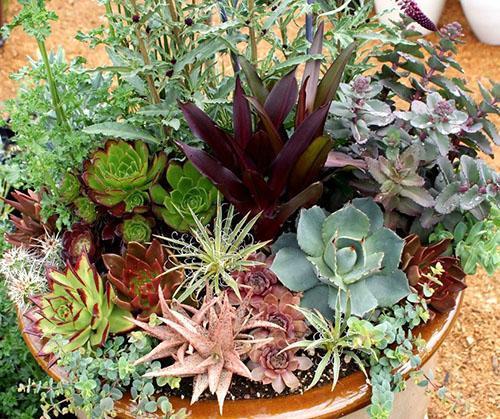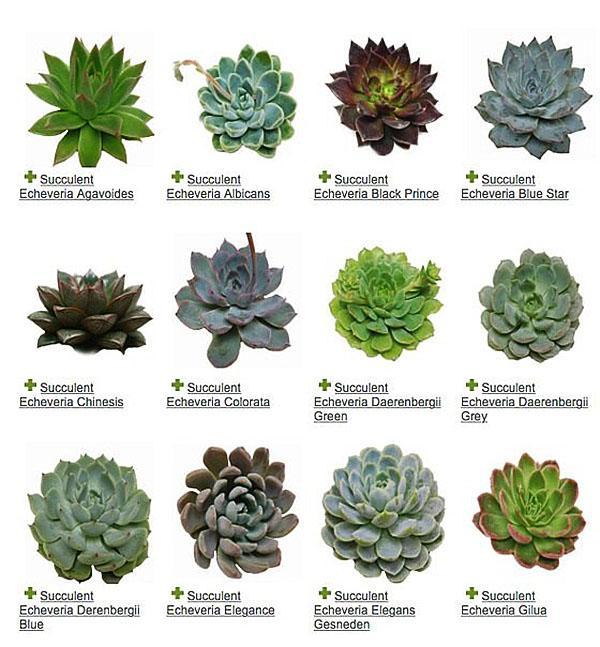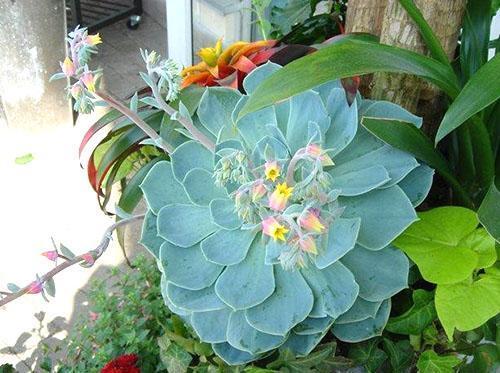Get to know the different types of Echeveria from the photo and short description
 Echeveria or stone flower is unusual, used in indoor cultivation and has many varieties. Plants differ in shape, color, structure of leaves and flowers, which conveys a photo of Echeveria. There are currently over 150 varieties, but breeders are getting amazing new hybrids. From a small shrub to a compact loose head of cabbage, you can find a plant in a greenhouse and home breeding.
Echeveria or stone flower is unusual, used in indoor cultivation and has many varieties. Plants differ in shape, color, structure of leaves and flowers, which conveys a photo of Echeveria. There are currently over 150 varieties, but breeders are getting amazing new hybrids. From a small shrub to a compact loose head of cabbage, you can find a plant in a greenhouse and home breeding.
Flowers on long legs, hovering above the plant, give a special decorative effect to the Echeveria succulent. Their shade changes with the weather. On clear sunny days, you can get a rich red inflorescence, on cloudy days, a yellow flower will bloom.
Echeveria classification

The plant catalog allows you to visually see the specimen and get acquainted with its description. Considering the plants, it becomes clear that the raging passions pass, and the world is eternal. Nature slowly creates its masterpieces, polishing each species for millennia.
Consider a photo of the Echeveria species:
- agave;
- shiny;
- cushion;
- giant;
- graceful.
Each type of succulent includes varieties, we will consider some of them in more detail.
Echeveria agave
 A photo of agave echeveria is a loose rosette of leaves of a complex shape with the transition of the scapula to an oval and a pointed tip. The surface is waxy, the color range is extensive, but all plants of this species have a thorn at the pointed end. Echeveria agavoides blooms in late spring, flowers emerge from the axils of the leaves and the crown create a colored cloud at a height of 40 cm above the plant.
A photo of agave echeveria is a loose rosette of leaves of a complex shape with the transition of the scapula to an oval and a pointed tip. The surface is waxy, the color range is extensive, but all plants of this species have a thorn at the pointed end. Echeveria agavoides blooms in late spring, flowers emerge from the axils of the leaves and the crown create a colored cloud at a height of 40 cm above the plant.
Echeveria related, AFFINIS
 The succulent plant was described in 1958. The plant has a rosette with a stem no more than 5 cm and a diameter of up to 20 cm. The rosette grows quickly, is unpretentious and takes root easily. With a lack of lighting, it turns green.
The succulent plant was described in 1958. The plant has a rosette with a stem no more than 5 cm and a diameter of up to 20 cm. The rosette grows quickly, is unpretentious and takes root easily. With a lack of lighting, it turns green.
Echeveria graceful
 Echeveria elegans is offered in several varieties that share the following traits:
Echeveria elegans is offered in several varieties that share the following traits:
- a thick stem that can lay down and take root;
- leaves are light almost white, collected in an outlet up to 15 cm;
- leaves end with thorns;
- new rosettes are formed from lateral shoots in the leaf axils.
Echeveria graceful flower is perfectly shown in the photo.
 Here is another variety of this type of Echeveria.
Here is another variety of this type of Echeveria.
Echeveria Darenberg
 The plant takes place with the help of creeping stems, on which rosettes with leaves, covered with a bluish bloom, with a reddish border take root. This species blooms for a long time from April to June, but the peduncles are short. The rosette resembles a half-open spruce cone.
The plant takes place with the help of creeping stems, on which rosettes with leaves, covered with a bluish bloom, with a reddish border take root. This species blooms for a long time from April to June, but the peduncles are short. The rosette resembles a half-open spruce cone.
Echeveria humpback-flowered
The plant is represented by many varieties. The unusual shape of the leaves and the straight stem are repeated in different versions of Beauty, adding a bright ear of the flower. The leaf blade can grow up to 20 cm long and 15 cm wide. The sheet is concave.  There are varieties here with a metallic sheen or lumpy. One minus, it is almost impossible to achieve flowering of this variety at home.
There are varieties here with a metallic sheen or lumpy. One minus, it is almost impossible to achieve flowering of this variety at home.
 In nature, it is a shrub up to 60 cm high, with two or three branches. Peduncles are thick, up to 6 cm in diameter, blooms in autumn and winter.
In nature, it is a shrub up to 60 cm high, with two or three branches. Peduncles are thick, up to 6 cm in diameter, blooms in autumn and winter.
 The well-known variety "Black Prince" also belongs to humpback flowers, the leaves are pink-gray.
The well-known variety "Black Prince" also belongs to humpback flowers, the leaves are pink-gray.
 "Pearl of Nuremberg" with red-brown leaves.
"Pearl of Nuremberg" with red-brown leaves.
Echeveria Lau
 The plant requires a special description. On the short-stemmed form, large fleshy leaves with a waxy coating grow. There are few leaves, but their appearance makes you smile. They resemble pancakes covered with a wax coating. Even flowers in this protective layer. But this plaque requires careful handling. The flowers of this plant are large, up to 1.5 cm in diameter. This flower grows slowly and is demanding to care for.
The plant requires a special description. On the short-stemmed form, large fleshy leaves with a waxy coating grow. There are few leaves, but their appearance makes you smile. They resemble pancakes covered with a wax coating. Even flowers in this protective layer. But this plaque requires careful handling. The flowers of this plant are large, up to 1.5 cm in diameter. This flower grows slowly and is demanding to care for.
Look brilliant
 The group of plants is represented by several varieties of Echeveria, striking with strict geometric shapes and coloring of leaves. In nature, it is a shrub with little branching, leaves, like blades, up to 10 cm long, sometimes with a notch along the outer edge. Flowers are located on peduncles up to half a meter high. They can be tassels or umbrellas. The plant blooms in winter or early spring.
The group of plants is represented by several varieties of Echeveria, striking with strict geometric shapes and coloring of leaves. In nature, it is a shrub with little branching, leaves, like blades, up to 10 cm long, sometimes with a notch along the outer edge. Flowers are located on peduncles up to half a meter high. They can be tassels or umbrellas. The plant blooms in winter or early spring.
Echeveria amoena
 The flower is native to the dry foothills of Mexico. Shoots are flat with active branching. Rosettes on them are formed from bluish leaves. The shape of the leaves is triangular, the flowers are yellowish with a red sheen. These plants are considered rare and highly valued by amateurs.
The flower is native to the dry foothills of Mexico. Shoots are flat with active branching. Rosettes on them are formed from bluish leaves. The shape of the leaves is triangular, the flowers are yellowish with a red sheen. These plants are considered rare and highly valued by amateurs.
Bristly echeveria
 The plant has dense balls of rosettes, dark green and with dense pubescence. These flowers rise 30 cm above the mother bush and are also covered in a haze of pubescence.
The plant has dense balls of rosettes, dark green and with dense pubescence. These flowers rise 30 cm above the mother bush and are also covered in a haze of pubescence.
Cushion echeveria
 The flower is also distinguished by strong leafy pubescence. But his leaves are with sharp tips. There is no pubescence only inside the flower. The leaf hairs may be white or reddish. The sheet itself, with a length of about 5 cm, has a centimeter thickness.
The flower is also distinguished by strong leafy pubescence. But his leaves are with sharp tips. There is no pubescence only inside the flower. The leaf hairs may be white or reddish. The sheet itself, with a length of about 5 cm, has a centimeter thickness.
Echeveria Sho
 The plant is a perennial succulent. Unlike other plants of this group, they have a flat leaf blade without great thickness. The plant looks more like a loose head of cabbage. Shaviana blooms at the height of summer, releasing long-flowering brushes. For the winter, this type of Echeveria sheds almost all the leaves.
The plant is a perennial succulent. Unlike other plants of this group, they have a flat leaf blade without great thickness. The plant looks more like a loose head of cabbage. Shaviana blooms at the height of summer, releasing long-flowering brushes. For the winter, this type of Echeveria sheds almost all the leaves.
 The described type of succulent, named after the breed of decorative dogs, represents a stem 5 cm high and 1 cm in diameter, on which a fabulous rosette of fleshy obovate leaves is collected and of fabulous proportions. attached to the trunk by the side resembling a shoulder blade. Sharp-pointed grayish white leaves arranged in a spiral. The tips of the leaves are colored. The description contains varieties known and not so well. The aim was to show all the diversity and varieties of Echeveria.
The described type of succulent, named after the breed of decorative dogs, represents a stem 5 cm high and 1 cm in diameter, on which a fabulous rosette of fleshy obovate leaves is collected and of fabulous proportions. attached to the trunk by the side resembling a shoulder blade. Sharp-pointed grayish white leaves arranged in a spiral. The tips of the leaves are colored. The description contains varieties known and not so well. The aim was to show all the diversity and varieties of Echeveria.